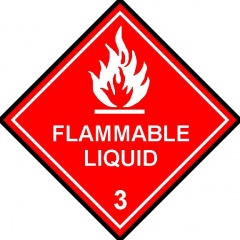Acrylonitrile
| Infobox on Acrylonitrile | |
|---|---|
| Example of Acrylonitrile |  |
| Facts | |
| Origin | - |
| Stowage factor (in m3/t) | - |
| Humidity / moisture | - |
| Ventilation | - |
| Risk factors | See text |
Acrylonitrile
Description / Application
Acrylonitrile is a chemical compound with the formula C3H3N. This colourless liquid often appears yellow due to impurities. It is an important monomer for the manufacture of useful plastics such as polyacrylonitrile. In terms of its molecular structure, it consists of a vinyl group linked to a nitrile.
Acrylonitrile is used principally as a monomer to prepare polyacrylonitrile, a homopolymer, or several important copolymers, such as styrene-acrylonitrile (SAN), acrylonitrile butadiene styrene (ABS), acrylonitrile styrene acrylate (ASA), and other synthetic rubbers such as acrylonitrile butadiene (NBR). Dimerization of acrylonitrile affords adiponitrile, used in the synthesis of certain polyamides. Small amounts are also used as a fumigant. Acrylonitrile and derivatives, such as 2-chloro-acrylonitrile, are dienophiles in Diels-Alder reactions. Acrylonitrile is also a precursor in the industrial manufacture of acrylamide and acrylic acid.
Shipment / Storage
Colourless, mobile liquid with a mild pungent odour.
Flashpoint:-5°C. Explosive limits: 3% to 17%. Partially miscible with water. Toxic if swallowed, by skin contact or by inhalation. Practice has shown that this substance may leak from packages that ordinarily are leakproof to other chemicals
For overseas carriage aspects of Chemicals, the readers are recommended to acquire or have access to a good chemical dictionary, and a copy of the International Maritime Dangerous Goods (IMDG) Code, issued by the International Maritime Organisation. Also consult the applicable MSDS sheet.











